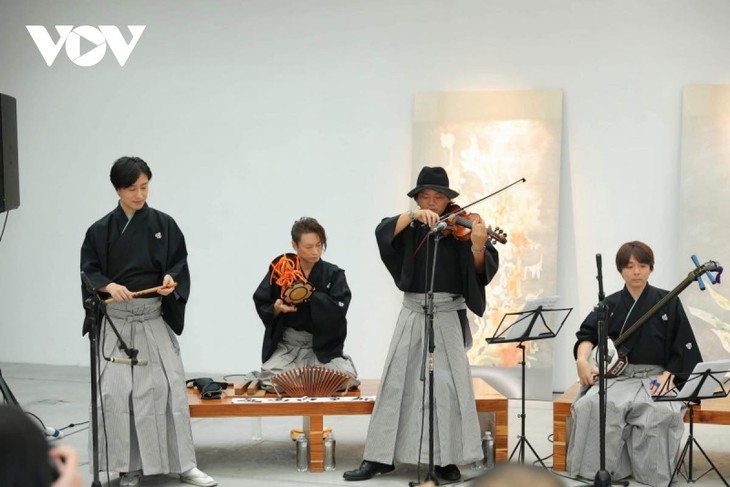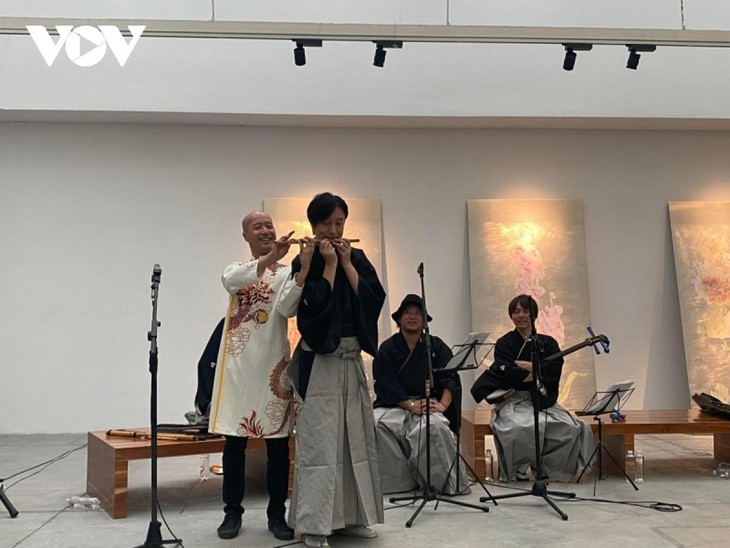(VOVWORLD) - Vietnam’s music fans have learned about Japan’s traditional musical instruments at a recent charity concert in Hanoi involving Vietnamese bamboo ensemble New Vitality and Japanese music group Ryoma Quartet. The event was part of activities to mark 50 years of diplomatic relations between Vietnam and Japan.
 Members of the Ryoma Quartet. Members of the Ryoma Quartet. |
The Ryoma Quartet wants to bring Japanese culture to the world through music and builds friendship between the citizens of different countries. The quartet has toured Spain, Thailand, Malaysia, Bulgaria, South Korea, and other countries.
Samisen is a traditional instrument often used in Japanese folk music. The three-stringed instrument is played with a plectrum called a bachi. Its construction is similar to that of a guitar or a banjo, with a neck and strings stretched across a resonating body. The neck of the Samisen is fretless and slimmer than that of a guitar or banjo. The body resembles a drum, with a hollow body that is covered front and back with skin.
"The Samisen has various kinds but the one I’m playing originates from Aomori Prefecture. The locals say blind musicians played the instrument to earn a living," said Masakatsu of the Ryoma Quartet.
The Nohkan and the Kotsuzumi are two other traditional music instruments of Japan commonly used in Imperial Noh and Kabuki theatre.
The Nohkan has similarities to the Vietnamese bamboo flute. The Kotsuzumi is a small wooden hand drum, with an hourglass body and two drum heads held in place with cords. Jinko, who plays the Kotsuzumi, said that Kotsuzumi players adjust the cords to set the pitch of the drum.
"My left hand holds on to the cords and my right hand is used to strike the drum. The drummer can produce different pitches by changing the rope tension with gentle left-hand squeezes. The player chants loudly to the drum sounds."
 Conductor Dong Quang Vinh instructs an artist from the Ryoma Quartet how to play the Vietnamese bamboo flute. Conductor Dong Quang Vinh instructs an artist from the Ryoma Quartet how to play the Vietnamese bamboo flute. |
Traditional music instruments of Vietnam and Japan share similarities, according to conductor Dong Quang Vinh, founder of the New Vitality ensemble.
"I learned that Vietnamese and Japanese flutes can be played with similar blowing and fingering techniques." he said, adding that the Samisen sounds echo the Tam and the Tinh of Vietnam, but Japanese people tend to play more forcefully," said Vinh.
During the concert, the audience enjoyed the music while learning about the history and techniques of Japanese traditional musical instruments. Some audience members said:
"The concert was meaningful to me because it gave me more details about Japan’s musical instruments, which I had already heard a lot about."
"I’d never heard of the Kotsuzumi before, but I was particularly impressed by the drummer. I was also amazed by the artists playing the Samisen with a thick plectrum made of turtle shell."
The collaboration of artists from Vietnam and Japan on a Vietnamese folk song demonstrated the beautiful marriage of their two music traditions.